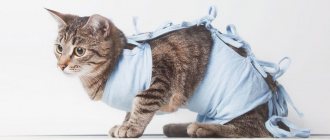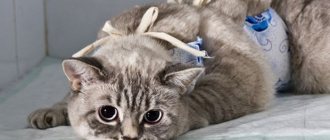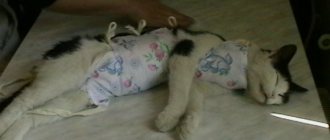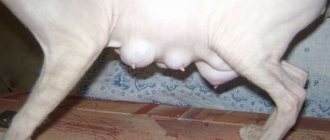How long does it take for a cat to recover from anesthesia?
The operation is performed in a clinic or at home. The animal's behavior seems strange in the first 5 or 6 hours after anesthesia. You can't leave him alone. At this time, the anesthetic effect ends and the animal’s postoperative sutures begin to hurt.
Urinary incontinence occurs, but this phenomenon is temporary and passes quickly. The pet's behavior returns to normal within one or two days. The exact time of residual effect of narcotic substances depends on the type of anesthesia, age and other individual characteristics of the animal. During this period, the pet needs the care of the owner.
Frequently asked questions from hosts
What are the signs of a neutered cat?
A castrated cat does not have any obvious signs, especially if the animal has a luxurious coat. Upon palpation, you can find that the external genital glands are absent.
Why does a neutered cat have discharge?
A castrated cat may have discharge for the first few days after surgery. If the discharge is intense and lasts more than 2 days, then the pet should be shown to a veterinarian.
How to castrate a cat yourself?
The owner cannot remove the gonads on his own. The operation should only be performed by a qualified specialist.
Why does a neutered cat climb on a cat?
A neutered cat can show interest in a cat for several reasons:
- this is done by animals that have recently undergone surgery; their hormonal status has not yet undergone major changes, and the cat’s body still receives a portion of sex hormones;
- A castrated male can pursue the opposite sex even if the animal was operated on in adulthood.
What is better – spaying or neutering a cat?
In veterinary practice, castration is usually performed. Sterilization - ligation of the spermatic cords - is used extremely rarely. After this manipulation, the animal loses the ability to reproduce, but all the negative aspects of behavior remain. The sterilized cat still continues to mark its territory and ask to go outside.
Is it possible to castrate a cat at home?
At home, you can castrate an animal by calling a veterinarian to your home. You must first check the health of your pet. Home surgery should not be used if the cat is an adult or has chronic diseases.
Why does a neutered cat yell for no reason?
The reason for crying in a castrated cat may be that the hormonal status has not yet changed after castration and the animal is susceptible to the action of sex hormones. The cause of inappropriate behavior may also be pain if there are complications after surgery. The animal should be shown to a veterinarian and the cause should be determined.
What does a neutered cat look like from behind?
When castration occurs, the gonads of an animal are removed. This can only be seen from the back of the cat if the pet is a short-haired breed. If there is pronounced fur, it is difficult to determine visually that the animal’s gonads have been removed.
Cat after castration
When castrating a cat, do the testicles remain or not?
If full castration is performed, the testicles (gonads) are completely removed. During sterilization, only the spermatic cords are ligated; the gonads are not completely removed.
Should cats be given injections instead of castration?
Unlike females, male cats do not have a cyclical sexual cycle. In this regard, it is not advisable to use any injections based on hormonal substances. In addition, drugs that control sexual behavior in animals are unsafe and can cause the development of cancer.
Castration of a domestic cat is a humane solution to the problem of an animal’s sexual behavior. Compliance with the optimal timing of surgical manipulation allows you to minimize postoperative complications and guarantees adequate behavior of the animal in the future.
Timely castration is the key to comfortable keeping a pet, the prevention of many diseases, and improving the quality and life expectancy of a pet.
Features of inhalation anesthesia
Inhalation anesthesia is the sound sleep of an animal (general anesthesia), which is achieved due to gaseous substances entering the respiratory tract in certain doses and concentrations.
From the respiratory tract, through the pulmonary circulation, the drug used enters the brain, gently inducing reliable, controlled sleep.
Thus, the volatile substance used does not enter the systemic circulation, which means that inhalation anesthesia cannot have a negative effect on the internal organs of the abdominal and pelvic cavities.
Upon completion of the gas supply, the drug easily leaves the parts of the brain in a matter of minutes, then returns through the pulmonary circulation to the lungs and is exhaled outward.
Therefore, after such anesthesia, the animals are taken home in full consciousness. After just a couple of hours, the pet moves confidently, leads its normal lifestyle and may ask for food.
Little patient at an appointment with a veterinarian-anesthesiologist
Hence the conclusion: the volatile drug used does not linger in the animal’s body, and therefore does not cause serious consequences during the recovery period. This fact minimizes the time spent on care and makes it easier for the owner to care for the pet.
How cats recover from anesthesia after castration - features of the condition
The process of recovery from anesthesia is individual. Some pets behave aggressively, others wake up slowly and remain lethargic for a long time. An inexperienced pet owner runs the risk of being bitten or scratched.
The side effect of drugs is prolonged disorientation in space and impaired coordination of movements. To prevent the consequences of physical activity, the cat is placed in a place from which it cannot fall. The best option is to leave it in a carrier for a while, in a warm, dry place without drafts and away from heating radiators.
Be sure to read: Complications after castration of a cat: causes, types, symptoms and treatment, when you need to see a doctor
Rehabilitation of a cat at home
It is better to take a domestic cat owner who is accustomed to society immediately after the operation. The only option that justifies the need to stay in the clinic is complications that occurred during the operation. If it is very cold outside, you will need a heating pad, warm bedding, and a carrying case.
Approximately 30 minutes after the administration of anesthesia, the cat begins to raise its head and slowly move
From this moment on, you need to pay increased attention to the cat’s activity. The pet can lie quietly, or it can jump up and jump out of the window - you won’t guess.
Carry your cat only in a carrier and do not open the door unless absolutely necessary. Even if you are transporting your cat in your own car, it must be in a carrier! There are known cases when pets began to run around the cabin and disturb the driver, which led to an accident.
Immediately after the operation, the cat is given pain medication; your doctor should give you further recommendations, since the effect of the medicine will wear off after a few hours. Do not listen or believe if the doctor insists that the cat is not in pain. It has been proven that the use of painkillers for 2 days after castration is important! Almost all large clinics not only provide instructions on how to care for a cat at home, but also force you to sign a form stating that you are familiar with all aspects.
Do not leave the clinic for 20–30 minutes after surgery. During approximately this time, the effects of blood pressure regulating medications will wear off, which may lead to bleeding from the suture. Sutures are applied only to large cats; in animals of average build, the length of the incision does not exceed 1 cm
It is important to monitor the cat's position. It is better for the pet to always lie on its side, because in case of vomiting, the cat will not choke in this position
It is better not to remove the cat from the carrier immediately after arriving home. Remove the lid and door, place a heating pad next to your pet and make sure that the body temperature does not drop. For the cat to feel normal, the temperature in the room must be within the range of 21–24°C and adequate humidity. In the first few hours, it is better to cover the pet with natural woolen fabric (blanket, jacket).
If the cat sleeps for a long time, it needs to be turned from side to side every 30 minutes. Some quadrupeds sleep after anesthesia with their eyes open, the eyeballs protected only by the third, transparent eyelid. In this case, you need to forcefully close your pet’s eyes and gently massage them to provoke the release of tears. If the cat recovers from anesthesia for a long time and you cannot keep an eye on the eyelids, it is better to close them and stick them with an adhesive plaster.
After about 2-4 hours, you need to re-inject the painkiller. Please note that some medications lower body temperature, so it is better to give the injection in 2 stages, but half the dose.
Constantly monitor the condition of the cut. If ichor comes out of it, this is normal. Usually the cut dries out only on the second day. You should be alerted by scarlet blood, traces in the form of drops or puddles. Bleeding can only open after the cat begins to walk. Call your veterinarian immediately for further advice. Usually such problems are eliminated with medication.
When the pet begins to walk, there should be no windows open in the house (even for ventilation). It is better to limit the cat's movement to one room where he cannot hide or get stuck. Some pets are not active, but are very anxious, walk from corner to corner, meow... crash into furniture, fall. It’s not very pleasant, but this is one of the normal options, as anesthesia affects consciousness.
Many owners are concerned about the issue of feeding, especially if the veterinarian advises keeping the pet on a starvation diet. The most appropriate approach is pet-oriented. When recovering from anesthesia, the cat will want to drink. The client needs to be offered warm water, to which you can add a little sugar and salt.
After 3-4 hours, you can offer low-fat broth instead of water. If the cat refuses, do not insist, some animals do not eat for 20 hours in a row, the reason for this is severe nausea. If your cat is vomiting from water, put a few drops of it in his mouth - a small amount of liquid will not cause a gag reflex. The cat can be returned to a normal diet 3-4 days after castration.
What is anesthetic risk?
No matter how experienced the surgeon and anesthesiologist are, there is always the possibility of complications, even death. Anesthesia for cats is a serious burden primarily on the cardiovascular and respiratory systems. Minimizing anesthetic risks is the task of the veterinarian, who is obliged to individualize the standard regimen taking into account the characteristics of a particular cat. In many cases, the serious condition of a cat after anesthesia is a consequence of the use of drugs “at random”, without studying the condition of the mustachioed patient. To avoid problems, it is important to contact only competent specialists with an excellent reputation.
How to behave when a cat recovers from anesthesia, what to do?
The first three days of the pet should not be lost sight of. You need to monitor the healing process and do not let the cat lick the wound. Otherwise, infection and purulent inflammation are possible. To prevent licking, wear an Elizabethan collar. The seams are treated with products recommended by the veterinarian. If the cat quickly came to his senses, the wounds do not bother him, and they should not be treated again.
Clean water should be nearby at all times. If the animal wants to drink, but cannot do it, you need to wet the mouth with a syringe or pipette, but do not inject it forcibly. You cannot feed your pet on the first day.
An empty tray without filler is placed next to the convalescent person so that the animal does not clog the wound. The toilet should be cleaned daily, or even better after each visit. If the first bowel movements do not occur in the tray, there is no need to punish. It may be painful for a cat to climb. When the condition returns to normal, the habit of going to the toilet will be restored.
If a cat is soiled with urine, it should not be bathed. You should use refreshing wipes.
Pain reaction after surgery
Unfortunately, severe pain is a very common consequence in many cases of surgical castration. There is nothing unnatural about this: after all, the operation involves excision of the testes, and the procedure itself is carried out in an area rich in nerve endings.
The animal will show symptoms of pain and discomfort, especially when attempting to palpate the groin area.
- In severe cases, his breathing may become harsh and shallow, and the cat will fidget all the time, as he cannot find a comfortable position.
- In addition, the animal develops a stiff, “wooden” gait. The pet tries to move so that when walking it does not disturb the area of the operated scrotum.
- A strong, prolonged tremor (shaking) is quite typical.
- Your pet will avoid lit areas. Pets in such situations tend to climb into the far dark corner and sit there for a long time.
- If the owner tries to probe the genital area, the animal may show severe aggression, including attempts to bite and scratch the person.
Not in all cases these signs indicate something really serious. So, among the cats there are also “sissies”, for whom the trimmed and shaved skin of the scrotum causes a lot of inconvenience. Shaving it leaves microscopic cuts and abrasions that begin to itch and bother your pet.
Because of this, the animal constantly licks its perineum, becomes “wild”, and tries not to show itself. This behavior must be stopped, since constant licking of a postoperative wound can lead to its suppuration and necrosis. The easiest way to deal with licking is to use a surgical (“Elizabethan”) collar.
What should I do?
If you see your cat in pain, we recommend taking him to the clinic. There, specialists will determine what exactly is causing the pain reaction and will prescribe sedatives for your pet that can alleviate the animal’s condition.
In addition, in some cases of castration (sterilization of cryptorchids, for example), veterinarians themselves suggest leaving the cat with them for two to three days. This is done to ensure the success of the operation. Finally, if the specialist has doubts about the well-being of the pet after sterilization, he will immediately prescribe painkillers. Please note that the recovery period for old castrated cats is much longer and more difficult; such pets require special supervision.
To make it easier for your pet to recover:
- For the first week, keep them in a separate, dark room.
- Do not allow contact with other pets or children under any circumstances.
- Attempts to play with a weakened pet can lead to increased pain and increased aggressiveness of the cat.
- The less the animal moves in the first three days after surgery, the lower the intensity of the pain reaction.
- If your cat wants to go to the far corner and sleeps there, you should not disturb him: let the pet’s body recover. When your cat feels better, he will come out on his own.
But if you notice that the skin in the area of the operated scrotum is very red and covered with some kind of rash, you should not hesitate to visit a veterinarian. In some cases, ointments and creams containing anti-inflammatory corticosteroids are helpful. To calm itching, antihistamines are used, including the cheap and effective diphenhydramine. Please note that ointments and creams cannot be applied so that they get into the wound canal!
In what cases is it necessary to contact a veterinarian?
If the cat experiences visible discomfort, and three or more days have passed since the operation, the owners should definitely contact a veterinarian. In most cases, the post-operative wound after castration closes completely within three days.
If this period increases, the wound may become infected, which is extremely dangerous for the health of the animal. Thus, when the scrotal sac is contaminated with pyogenic microflora, the death of a pet from sepsis or general peritonitis is quite possible.
Inhalation anesthesia for rodents and ferrets
The most delicate pets at Alisavet are given inhalation anesthesia.
All three stages of creating gas anesthesia are carried out on these animals. However, there are small peculiarities here.
Inhalation anesthesia for small rodents is also carried out after premedication. In hamsters and rats, a tube is not inserted into the trachea, so the gas mixture enters through a special mask.
Ferrets and large rodents (guinea pigs, rabbits) are first given premedication, after which an intravenous catheter is installed, and then a gas mixture is also supplied using special masks.
03/09/18 Anesthesia for rabbits. Inhalation (gas) anesthesia
Cat after anesthesia: 6 signs that should alert the owner
A conscientious owner takes a vacation while caring for a neutered cat. Despite the simplicity of the operation, your pet may experience complications for a number of reasons.
The following are symptoms that may require veterinary attention:
- Low or high body temperature. The norm for cats is from 37.5 to 39.0 °C. The veterinary surgeon who performed the operation will tell you how often you need to measure your temperature. The problem is that anal measurement is painful. Therefore, purchase an ear or non-contact thermometer. The costs will pay off, since the need for thermometry will arise more than once during your life.
- Refusal to drink for a day and food for more than three days. If the cat does not drink, the concentration of salts in the urine will increase, which can lead to sedimentation and the onset of urolithiasis. Some cats may go 3 or more days without drinking when fed wet, prepared, canned food or natural food. But after the operation, a day is considered an acceptable period. Perhaps refusal to drink indicates intoxication, in which vomiting occurs when food or water enters the stomach. A healthy cat can go without food for 5 days. But, for the speedy healing of wounds, the operated pet needs nutrients. On the second day, a third of the feed is given from the norm, and at the end of the week the consumption is brought up to the recommended value.
- Stiffness in movements due to a feeling of interference in the perineum. This may be due to swelling of the sutures, but it is dangerous to act at your own risk.
- Pain when stroking the abdomen. Probably, the infection entered the abdominal cavity during the operation, or after it with a sudden movement, peritonitis develops
- Painful and difficult urination , accompanied by a plaintive meow.
- Dehiscence of the suture, bleeding for 2-3 days or the appearance of purulent discharge.
Be sure to read:
A sterilized cat asks for a cat: reasons, when it is the norm, what to do, how to avoid
Castrates and urolithiasis
Unfortunately, castration has several negative consequences. They appear, however, not always and not for everyone. But the biggest danger facing sterilized animals is urolithiasis.
With this pathology, stones (uroliths) form in the kidneys, urinary ducts, bladder, etc. The disease is accompanied by attacks, during which the cat may die from painful shock. In addition, one of the classic signs of ICD is the “leaking” of the animal. Simply put, a pet with this pathology constantly strains, which is why urine is released in small portions anywhere (and there is often blood in it). Due to the persistence of this phenomenon, some breeders even get the impression that their pet is constantly marking its territory.
If you notice that your neutered pet (especially if he is elderly) is straining all the time and frequently visits the toilet (the litter often remains completely dry), then it’s time to sound the alarm. In cases where constant pushing is accompanied by a strong pain reaction, from which the cat literally howls and wheezes, he needs to be urgently taken to the veterinarian, regardless of the time of day or day of the week. A cat (especially an old one) can go to the best of all worlds “just” in pain at any moment, so don’t hesitate. In short, urinary incontinence after castration can be a dangerous sign.
Is it necessary to use general anesthesia for dogs and other animals?
Knowing the serious consequences, you always want to bypass general anesthesia, namely, make it local - acting in a specific part of the body. But, this is only possible for minor procedures: stitching up the skin for minor damage, removing a tiny growth, or trimming an ingrown claw.
But before sterilization, it’s definitely not possible to do only epidural anesthesia. Animals are not people, and they certainly will not lie motionless until the end of the operation. And the reason for this is fear.
And it will also not be possible to properly brush your teeth without general anesthesia - the pet is so stressed that not a single local anesthesia will keep a panicking animal on the doctor’s table.
Therefore, for operations and many procedures, pets need to use general anesthesia, and sometimes complex.
How long can a cat have a fever after castration?
After castration, as after any surgical intervention, it is necessary to monitor body temperature. In the first hours it may drop below 37 °C. This is explained by stress, blood loss, and slowing of metabolism under the influence of anesthesia. The cat may shiver, so it should be well wrapped.
The advice to cover your pet with heating pads is questionable, as it promotes bleeding. The temperature should return to normal within 24 hours. If hypothermia continues for the second day, you should inform your veterinarian.
But, on the first day the temperature can rise to 40 °C. If no other pathological symptoms are noticed, there is no need to worry. But when a pet has a fever 4 or more days after surgery, veterinary care is necessary: an inflammatory process develops. You should not give your cat antipyretic medications, since their effect on humans and cats is different.
The cat is shaking long after surgery
As you already understand, short-term trembling that goes away over time is not dangerous. However, if the cat is shaking for a long time, then this sign signals problems
Important!
If you discover this symptom and it does not go away, you should immediately contact a veterinary clinic to determine the causes and timely treatment.
Inflammatory process
Trembling a day after surgery is a sure sign that there are some problems. Perhaps the symptom is caused by a fever, which was provoked by an inflammatory process that began in the body.
If the matter is really inflammation, then the following symptoms will indicate this:
- lack of appetite;
- suture swelling;
- discharge of ichor, pus from the wound;
- the appearance of vomiting;
- apathy and indifference of the animal.
If trembling is accompanied by any of the above symptoms, you should definitely visit a veterinarian. Only after an examination will he be able to make a diagnosis and prescribe the necessary treatment.
Lack of vitamins
Convulsions and tremors can be caused by a lack of vitamins in the body, namely magnesium, calcium or vitamin B. Usually, improvements occur after the missing vitamins are added to the pet’s diet. The required course is about 10 days.
Interesting!
Veterinarians advise adding brewer's yeast to your pet's diet in order to provide her with the necessary amount of vitamin B. Consult your doctor about this step.
Fatigue from physical activity
Sometimes cats that have just been spayed may flinch after physical activity. This process is similar to how a person’s legs shake after running. With the same success, trembling goes away after some time in cats. However, if the pet has rested, but the trembling has not gone away, then this is a reason to visit the veterinarian.
Important Takeaways
Some operations are performed only once in a lifetime (sterilization of a dog, sterilization of a cat, castration of a male or female cat), so let this surgical intervention be carried out in excellent conditions and with fully controlled anesthesia.
Take the time to find a veterinary clinic that offers gas anesthesia, and don’t skimp on traveling if the chosen facility is far from you. It's worth it!
Easy awakening after inhalation anesthesia
And if any procedure (for example, brushing teeth) or surgery (for injuries and other pathologies) must be performed more than once for forced reasons, then choosing inhalation anesthesia at some point may simply save the life of your cat or dog.
Abnormal stool
After surgery, the cat's intestinal function may be disrupted and constipation or diarrhea may appear, which is accompanied by pain and brings additional suffering to the animal. You need to pay attention to the following signs:
- refusal to eat;
- plaintive meow;
- absence of acts of defecation;
- periodically appearing trembling of the back of the body.
If your cat is constipated, you need to purchase a laxative for her on the recommendation of a veterinarian and change her diet. At home, you can use regular Vaseline.
Diarrhea occurs after exposure to toxins contained in anesthesia . In this case, the cat should limit drinking and feeding and use medication prescribed by the veterinarian. At home you can drink rice water.
© shutterstock
Sterilization and post-operative care of a cat
Sterilization (castration) operation – if you decide to have a sterilization operation for your pet, we suggest that you familiarize yourself with the recommendations for caring for your cat after the operation, because the postoperative period is the most important, and it falls on your shoulders. After the operation, the veterinarian must tell you about all the intricacies of caring for the animal after anesthesia.
Read: Sterilizing a cat
Here is a list of our recommendations that will definitely be useful to you.
Positive consequences after castration of a cat
Sterilization has a number of purposes: economic, preventive and therapeutic.
Sterilization has a number of serious advantages:
- reducing the risk of tumor development;
- immunodeficiency and leukemia viruses are rarely found in sterilized males;
- the likelihood of prostate diseases decreases;
- absence of unpleasant odor of urine in the room.
Be sure to read:
After sterilization, a cat sleeps a lot and is lethargic: normal or pathological, what consequences may occur after surgery
After removal of the gonads, testosterone production decreases. The animal becomes calmer, a balanced psyche is one of the factors influencing longevity.
First hours
The first days of the postoperative period are considered critical, during which the owner must monitor the cat’s condition. When you arrive home, you need to place your pet on the floor in a quiet place, away from heating radiators and drafts. You should not place a sleeping cat on the bed; it may fall and hurt itself.
Typical cat behavior after anesthesia is a cocktail of mixed negative emotions. Gradually coming to its senses, the cat looks deeply unhappy, constantly tries to go somewhere, staggers, has difficulty holding its head up, crashes into walls, and cannot get into the doorway. It’s painful and scary to watch, your heart aches with pity, but it’s important to pull yourself together and realize that all this is the norm. Until muscle tone is restored, you need to hold your pet, not allowing it to wander around the apartment or jump on the furniture: affection, quiet conversations and light stroking will certainly help, unless the pet shows aggression.
Sudden aggression in a cat after anesthesia is also normal. The pet is disoriented, her paws do not obey her, it is difficult to concentrate, calculate the distance, and it is difficult to assess the situation as a whole. The cat is frightened, tries to climb higher or hide deep under the bed, and the owner not only does not allow her privacy, but also constantly climbs with a thermometer, feels her nose, ears, and intrudes in every possible way. How can you not get angry? To reduce emotional pressure, you should close the curtains, ask your family to be quieter and once again not approach the cat, observing its actions from the side.
How does a cat behave when it wakes up?
Most likely, you shouldn’t expect absolutely adequate behavior from a barely awakened pet. Of course, he is unlikely to walk around the apartment trying to catch non-existent butterflies (and this doesn’t happen to people), but there will be certain oddities.
Based on this, veterinarians give a number of tips to owners of operated animals:
- There is no need to place your pet on sofas, ottomans, beds and any other places where he could fall. Remember that after anesthesia, your cat, usually so graceful and dexterous, may remain for some time in a state of “vegetable”, with little idea of where he is and what he is doing. The problem is that an animal with poor motor coordination (and due to general anesthesia it always is) can fall and be seriously injured, even if the height of the fall is measured in a few centimeters.
- Don't expect your cat to immediately remember where his litter box is. A disoriented animal simply will not reach it, creating a puddle somewhere along its route. So place the litter box within the cat's line of sight and reach.
- The same applies to a bowl of clean drinking water. There is no need to place it half a kilometer away from your barely awakened pet on the first day after sterilization. It is unlikely that he will be able to walk a long distance without falling or, again, making a puddle under himself.
During the first hours, your pet will need special care. He needs to be constantly watched. Remember that in some cases, again, you need to call a veterinarian immediately. So, if a cat decided to go to the toilet “in a big way”, but it didn’t turn out very well (the back of the body is stained with feces), then the dirt should be immediately removed and the doctor should be called immediately.
The problem is that the area of the operated scrotum is likely to be contaminated with pathogenic and conditionally pathogenic microflora. Most likely, you will have to prescribe the cat a course of antibiotic therapy. Otherwise, there is a high probability of sepsis and subsequent death of the animal.











